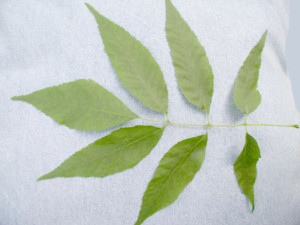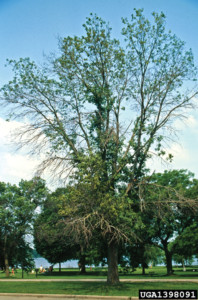The recent string of crisp, clear autumn days allows us to get out and appreciate the beginning of the seasonal leaf color change. Honeylocust trees started the show with their warm golden color, and now the Ash trees are approaching full glory. Maples will follow.
We are dedicating this issue of Nature’s Notes to Ash trees as they put on their season-ending show. It is always important to take time to enjoy our surroundings, but with the Ash tree, it’s especially the case. The Green Ash has a clear bright yellow fall color, and the White Ash exhibits one of the best purple/maroon fall colors with highlights of yellow. When they are at their peak color, they look like they are glowing inside. Absolutely beautiful and fleeting.
Some of us are lucky enough to have seen American Elms when they arched gracefully over entire streets, making a perfect tunnel of foliage; most of us have only heard stories. Dutch Elm disease became prevalent, and Elms quickly disappeared. Now, the Ash is going the way of the American Elm and soon may be a rare sight in our yards. Ash trees are dying due to the Emerald Ash Borer, but steps can be taken to protect them.
The following useful information is from the Illinois Department of Agriculture. If you are lucky enough to have a healthy Ash tree, take care of it. Protective injections are effective and can be done by a certified arborist. Water, fertilize and mulch as needed. Such beautiful trees are worthy of preserving for future generations to enjoy.
*****************************************************************************************************
Emerald Ash Borer
The emerald ash borer, (Agrilus planipennis tairmaire) is a small (1/2 inch long, 1/8 inch wide) metallic green beetle native to Asia. While it was first found in Michigan in 2002, it is likely that the beetle population had been established quite a few years before discovery. Discovered in Kane County Illinois in 2006, the beetles’ presence has since been found in Boone, Bureau, Champaign, Cook, DeKaIb, DuPage, Grundy, Iroquois, Kendall, Lake, LaSalle, McHenry, McLean, Ogle, Will and Winnebago counties. EAB’s natural spread is moderate, but its artificial spread can be rapid by people unwittingly transporting this pest through infested firewood and landscape waste. Artificial movement of infested trees has exacerbated the EAB problem in Illinois and North America. To protect our ash trees, it is our responsibility to minimize the spread of EAB by not transporting firewood outside of its local area. Fireplace owners should buy firewood from a known local source and burn all of it before May 1. Campers should buy firewood at your destination and/or burn all wood before leaving the campsite.
Life Cycle
The adult emerald ash borer emerges May-July and the female lays numerous eggs in bark crevices and between layers of bark. The eggs hatch in 7-10 days into larvae which bore into the tree where they chew the inner bark and phloem creating winding galleries as they feed. This cuts off the flow of water and nutrients in the tree, thereby causing dieback and death.
Ash Trees
Ash trees are very common in landscapes and most species, mainly white ash (Fraxinus Americana) and green ash (F. Pennsylvanica) are native to Illinois forests. It is estimated that as much as 20 percent of street trees in the greater Chicagoland area are ash.
* Compound leaves made up of seven small, glossy green leaflets (5-9 leaflets).
* Leaves, twigs and branches grow symmetrically in opposite pairs.
* Bark of mature trees is gray and furrowed, often appearing in a diamond pattern.
* Some ash trees will produce small canoe paddle-shaped seeds.
* Seedless ash trees are common.
* Some ash produce conspicuous hard, brown “flower galls” on their twigs.
Signs and Symptoms
The most visible sign of infestation is crown dieback. Branches at the top of the crown will die and more branches will die in subsequent years. As the tree declines, ‘suckers’, or new young branches, will sprout from the base of the tree and on the trunk. The bark may also split vertically and woodpeckers may feed on the beetle leaving visible damage on the bark. Successful treatments with insecticides are limited but continue to be studied. All ash trees near any new infestation will most likely become infested and die.
Adult beetles emerging from trees will leave a unique “O” shaped exit hole. This is a small 1/8 inch diameter distinctly “D” shaped hole that may appear anywhere on the trunk or upper branches.
Other Stressors
Ash trees may suffer from a number of insect disease or other problems that can cause similar symptoms.
Native borers also attack ash trees and leave different exit holes. The round or oval holes of native insect borers are not “O” shaped and are usually smaller or larger than those of the EAB.
You Can Help
DO NOT MOVE FIREWOOD
* Emerald Ash Borer can easily be transported in ash logs.
* Purchase firewood locally (within county) from a known source.
* Be sure to use all the firewood in the cold months so that no hidden EAB larvae or adults can survive on logs left through the spring.
* There are both state and federal quarantines in place that restrict the movement of ash logs, branches or other material in certain areas. The entire state of Illinois is under a federal quarantine, which restricts the movement of regulated articles across the state line. Additionally, an internal state quarantine is in effect for all or parts of 25 counties in northeastern Illinois. If you give or sell any ash stock or other hardwood originating from within the internal state quarantined area, inform the person receiving the wood of that fact and the restrictions on wood movement.
* Check www.lllinoisEAB.com for more detailed information.
* Monitor the health of ash trees. Look for dead and dying branches at the top of the tree’s crown and other EAB signs and symptoms.
If You Think You Have Emerald Ash Borer
If you suspect your tree has EAB, please take some digital photos of the tree and close-ups of the symptoms it is expressing and email those with contact info to: agi@jflinois.gov.
For assistance in identifying suspect insects and symptoms:
* Contact your city or village forester, arborist or public works official for assistance
* In the City of Chicago, contact 31 2-74BEETL (312-742-3385)
* Contact the Illinois Department of Agriculture at 800-64 1 -3934 or visit www.lllinoisEAB.com
* Contact your local University of Illinois Extension office by visiting http://web.extension.uiucdu/state/index.html or by calling 217-333-5900
* Visit www.emeraldashborer.info or http ://na.fs.fed.us/fhp/eab/
* Contact The Morton Arboretum Plant Clinic at 630-719-2424 or www.mortonarb.org
* Contact a certified arborist. To find one in your area, visit http://www.illinoisarborist.org
* Call the national EAB hotline at 866-EAB-4512.
Division of Natural Resources
Bureau of Environmental Programs
P0 Box 19281 Springfield, IL 62794-9281
217-785-2427 voice/TDD




